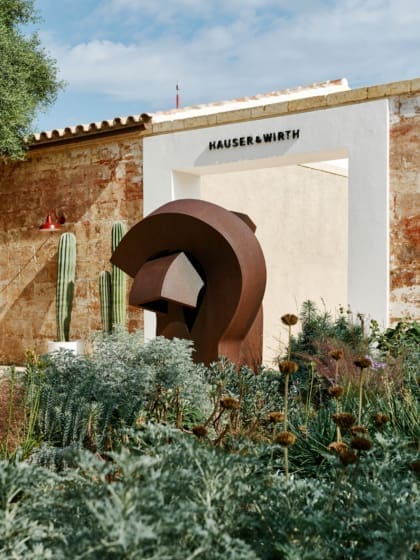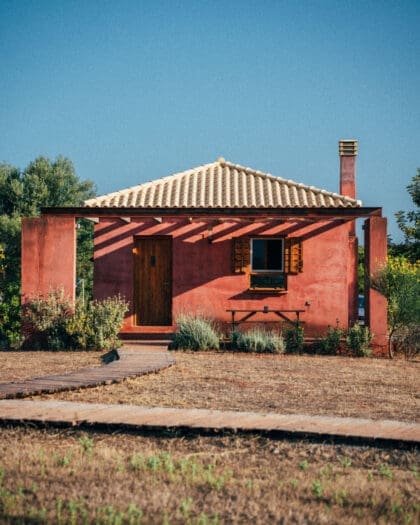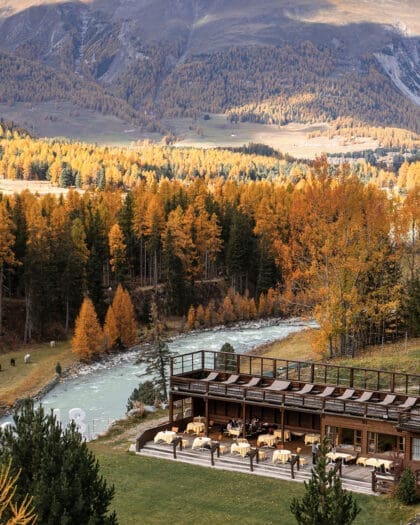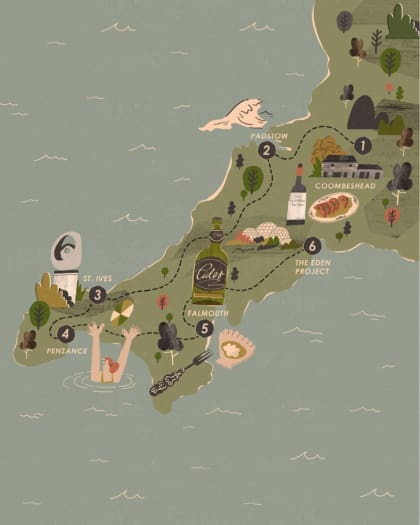
A Cornwall road trip: hotels, seafood and surfing beaches
Rugged landscapes, superlative seafood and a rich seam of cultural heritage make Cornwall one of the UK’s most compelling destinations. From hidden coves and artist enclaves to the lively towns of Falmouth, Penzance and Padstow, take an off-season road trip to this remote region’s charismatic corners
Few British regions stir the soul quite like Cornwall. Reaching out into the Atlantic at the UK’s south-western extent, its towering headlands, wind-carved cliffs and sheltered bays have shaped a way of life entwined with the surrounding seas. Surfers, smugglers, fishermen and artists alike have long been drawn to its waters, whose blue and turquoise hues dazzle under sunlight.
Celtic roots and pagan traditions colour Cornwall’s granite-strong sense of self – overheard in its protected national language and occasional calls for independence. A once thriving tin mining trade is now only visible in atmospheric remnants along the coastline, yet Cornwall’s beautiful beaches and hidden harbours remain. Deep Atlantic waters supply seafood to an increasingly sophisticated food scene and creative impetus comes courtesy of buoyant student communities, conservation projects and artist enclaves, all part of the county’s distinctive cultural patchwork.
Yet its remoteness means Cornwall doesn’t come easily to visitors. While a mainline train runs from London to Penzance, with offshoots to Falmouth, Newquay and St Ives, many highlights are best accessed independently. The newly christened South West 660 route map hugs the coastline, offering an excellent starting point for a Cornish adventure on two or four wheels (or perhaps on foot, via the South West coast path), with an increasing number of charging points making EV travel a sustainable option.
Read on for our complete Cornwall itinerary.
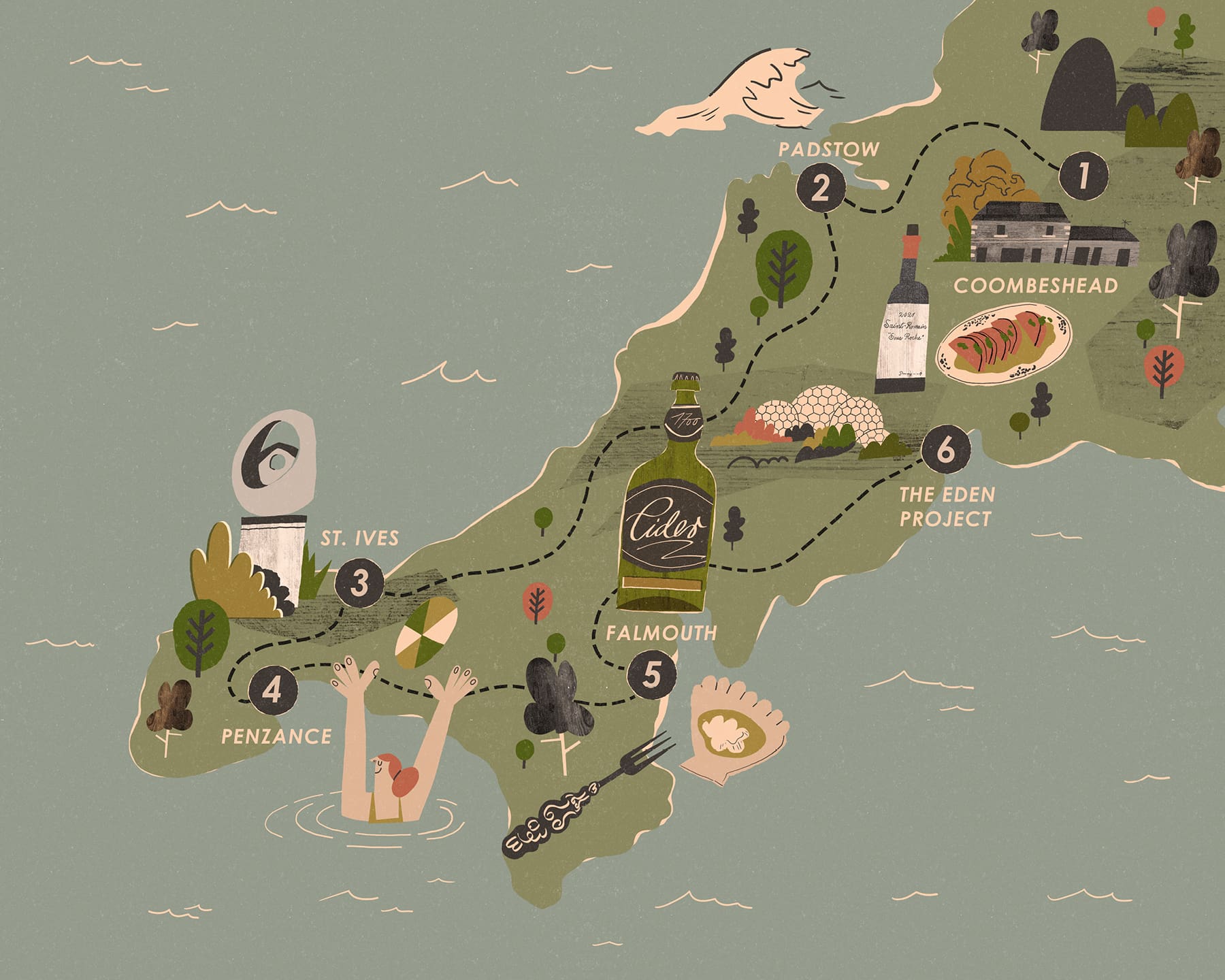
Off-season charm
The Cornish refer to outsiders fondly as ‘emmets’ or ‘blow-ins’, and as an emmet, you have a responsibility to keep the relationship cordial. Abundant charms combined with limited facilities mean Cornwall is susceptible to overtourism – its lanes, beaches and villages often struggle to cope with crowds in peak summer, which puts pressure on local communities. Instead, consider visiting during the shoulder seasons: spring is spectacular with hedgerows and blackthorn trees blossoming along empty beaches, while sea temperatures are at their warmest in autumn. Wintry off-season weather adds further drama to its rugged landscapes.
Follow ROADBOOK on a journey from east to west and back again, charting some of Cornwall’s best beaches, boutique hotels and year-round things to do.

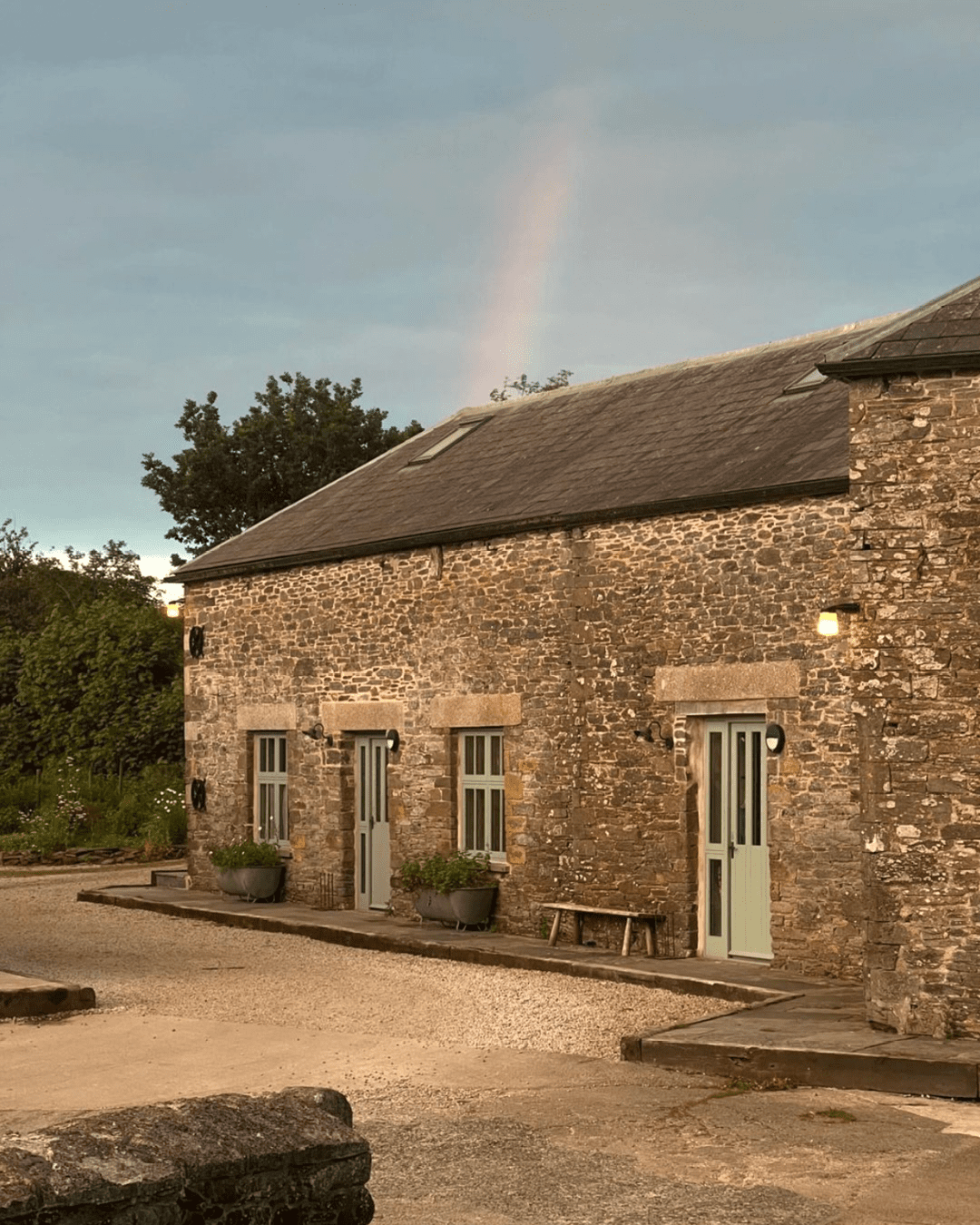
North coast
Cornish border to Padstow
Speeding past Devon’s border into Cornwall, hedgerows pop with the pinks and oranges of foxgloves, montbretia and honeysuckle – testament to this southern stretch’s sunny microclimate. While Cornwall’s fair weather means many of its most popular spots lie along its enviable coastline, it has also provided the perfect inland conditions for a new wave of growers, igniting a thriving farm-to-fork movement.
We pull off the A30 and follow country lanes to Lewannick, where Coombeshead Farm (considered one of the best farm-to-table restaurants in the UK) embodies this ethos. Its 66 undulating acres of regeneratively worked farmland supplies the food served at its homely 18th-century guesthouse, run by chefs April Bloomfield and Tom Adams. Here, nine rooms in muted tones provide an excellent bed for the night, while its unpretentious restaurant plates up the best of the season for supper. Loaves from its adjoining bakery are served at Cornwall’s best restaurants and are worth snapping up – alongside homemade jam and stoneware gifts – from the low-beamed farm shop before departure.
Reconnecting with Route 660 back towards the coast brings you past Bude, whose sea pool provides a bracing dip framed by dramatic cliffs, and idiosyncratic Boscastle, with its sheltered harbour and witchcraft associations, both of which make fascinating day trips. Onwards, against the north coast’s dramatic backdrop of folded, faulted sedimentary rocks and shingle beaches, Tintagel’s Roman origins and Arthurian legends are written into cliffs overlooked by castle ruins.
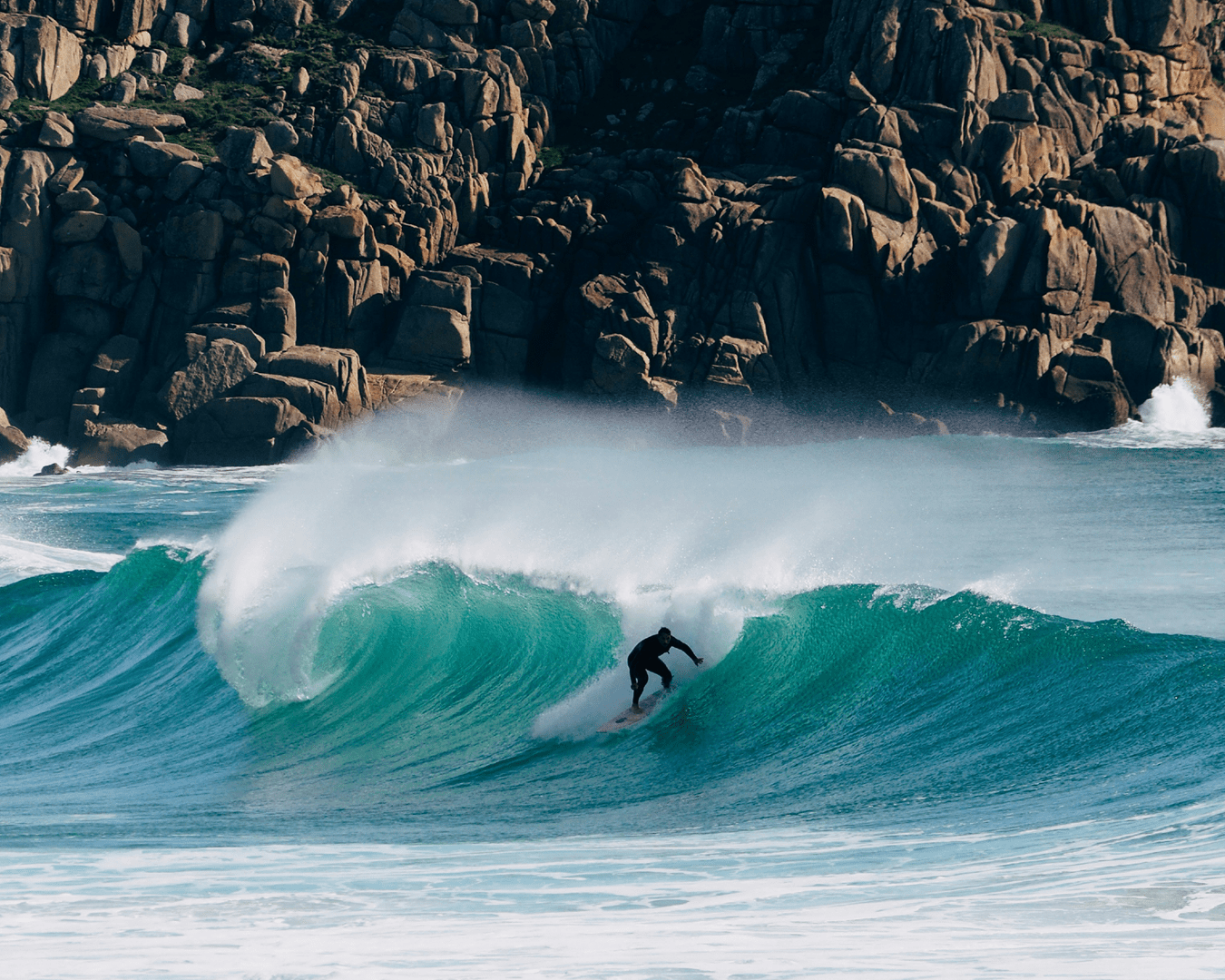
Padstow to St Ives
Cornwall’s north coast is a surfer’s paradise. Directly fronting the Atlantic, whose low-pressure weather systems and long reach serves up consistent swells, ensures that several of the beaches from Bude to Newquay rank among the world’s best breaks. Around the mouth of the River Camel, Polzeath and Padstow are a pair of picturesque coastal villages that provide a great jumping off point for surfers of all stripes. While Polzeath’s consistent, gentle waves are best for beginners, Trevone, Harlyn and Constantine Bays to the west of Padstow all offer something different to more accomplished surfers, depending on tide and winds, with low-lying rocks, rip tides and shipwrecks all hazards to navigate.
While slammed during summer months, Padstow’s appeal is clear: its working harbour and charming mazey lanes conceal a medley of bakeries, boutiques and pint-sized galleries. Here, high-profile chefs Rick Stein and Paul Ainsworth have created mini empires across multiple venues that range from the refined to relaxed.
A ferry ride across the Camel estuary delivers passengers to the former fishing village of Rock. While Rock’s Kensington-on-Sea credentials are renowned, with a waterfront lined by second homes, the daily changing chalkboard menu of Four Boys, opened by local chef Matt Wadsworth last year, champions locally landed fish and natural wine, making it a worthy pilgrimage.
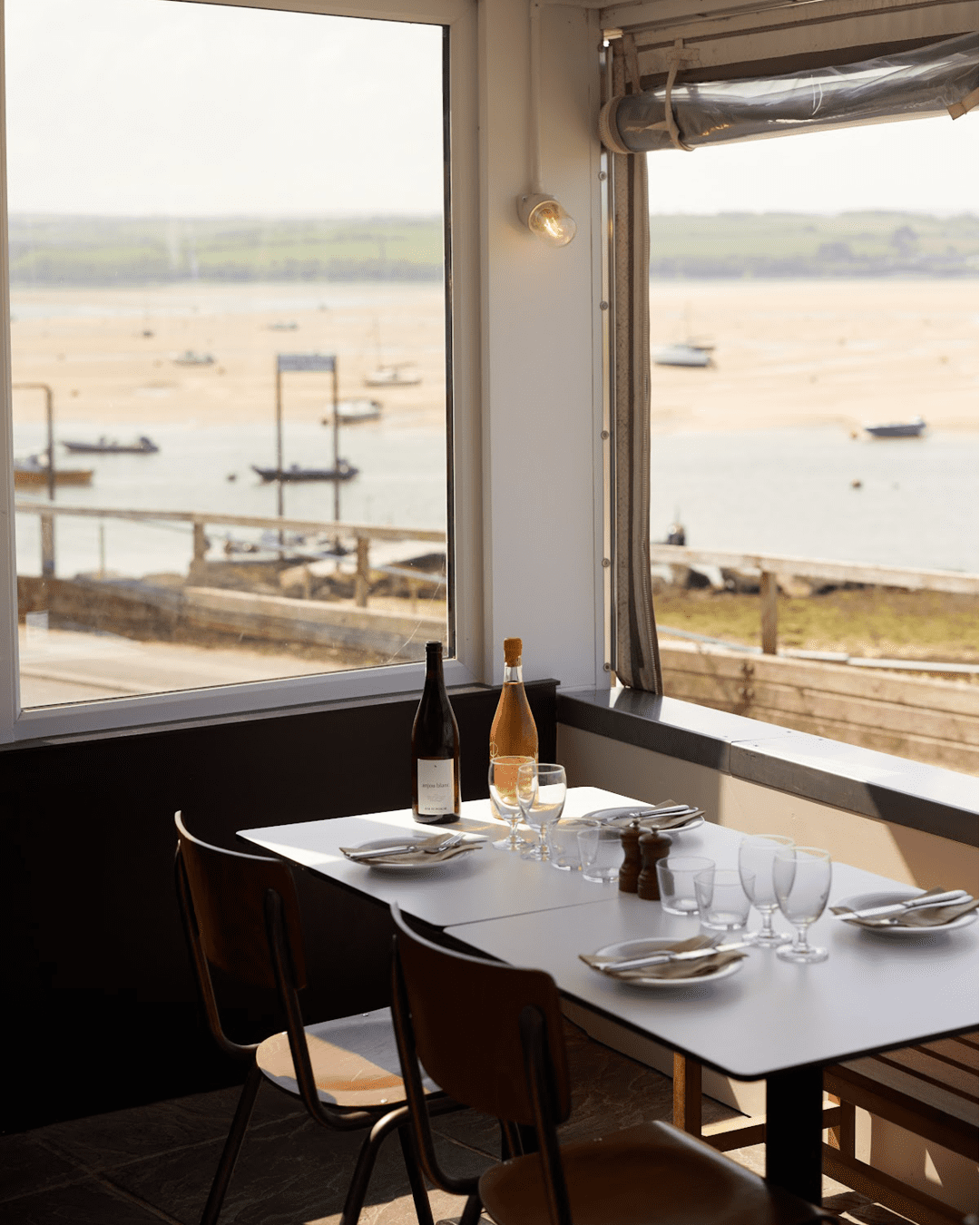
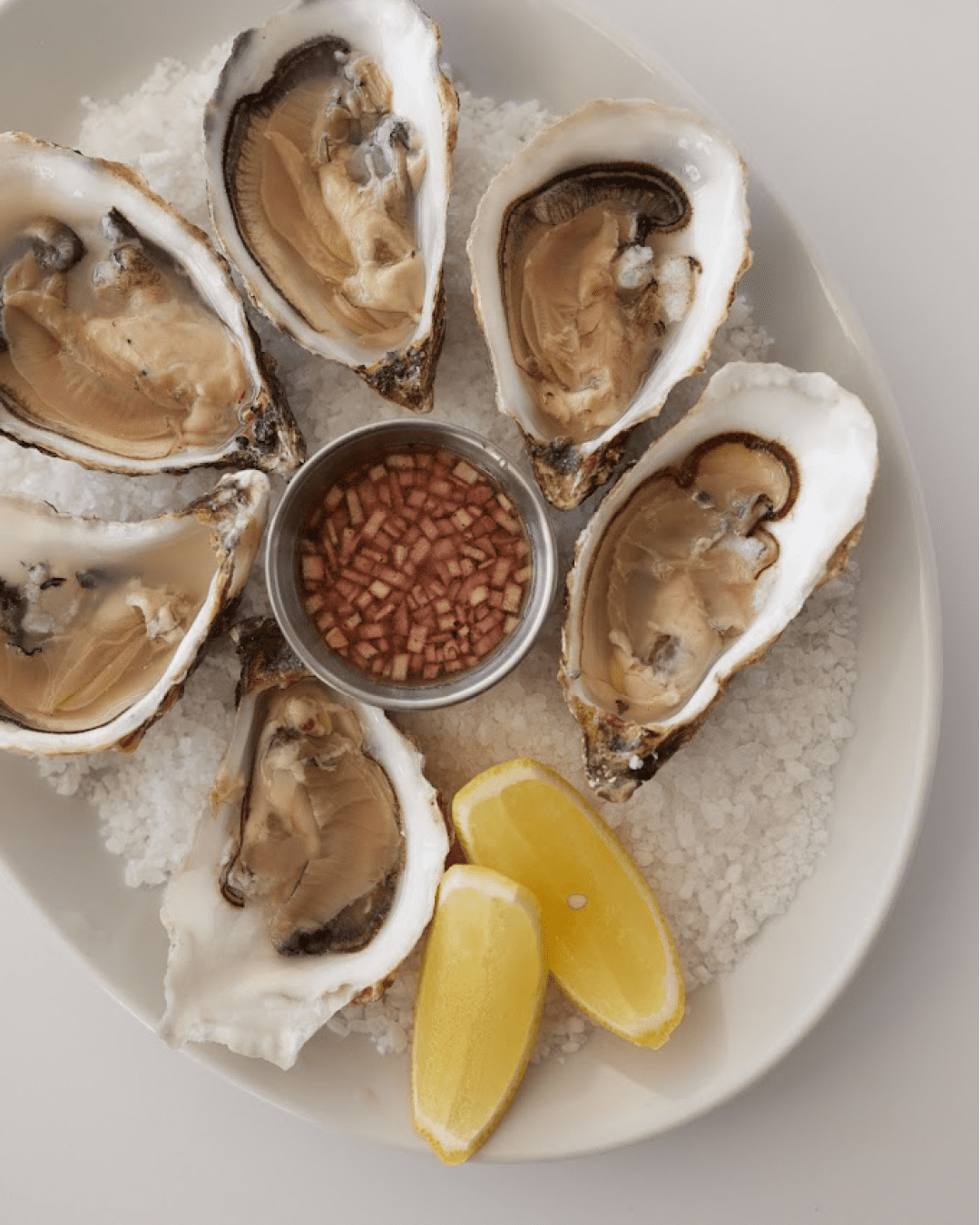
Along the shoreline past Newquay, Perranporth and the rolling headlands of the St Agnes Heritage Coast, we spot atmospheric ruins of Cornwall’s mining past, including the brick mine shaft at Wheal Coates – its lonely tower rising incongruously from the heather. Tin deposits were formed in this area by friction between granite and the complex rock geology of the area’s cliffs, and have been mined for millennia – Cornish tin most likely found its way into the hands of ancient Mediterranean cultures such as the Phoenicians. Just shy of St Ives, Gwithian beach is a particularly stunning stretch, with Godrevy lighthouse said to have inspired Virginia Woolf’s To the Lighthouse (1927).
Here, set back from the sandy dunes, Three Mile Beach is a laid-back scattering of self-catering apartments and beach “shacks”; a descriptor that doesn’t quite do justice to these luxurious weatherboarded lodgings. Decked out in boho beach decor and vibrant textiles, each is impeccably equipped: private terraces feature a barrel sauna, hot tub and barbecue. Inside, wetsuits hang from pegs, while board games and a log fire awaits.
We hike up to the cliffs above Mutton Cove, where grey seals lie languidly on the shore, and pass surfers capitalising on clean conditions before the sun dips below the ocean. Once back at the shack, the arrival of a pizza oven, dough and high-grade local ingredients provides all the tools for dinner in the fading light.
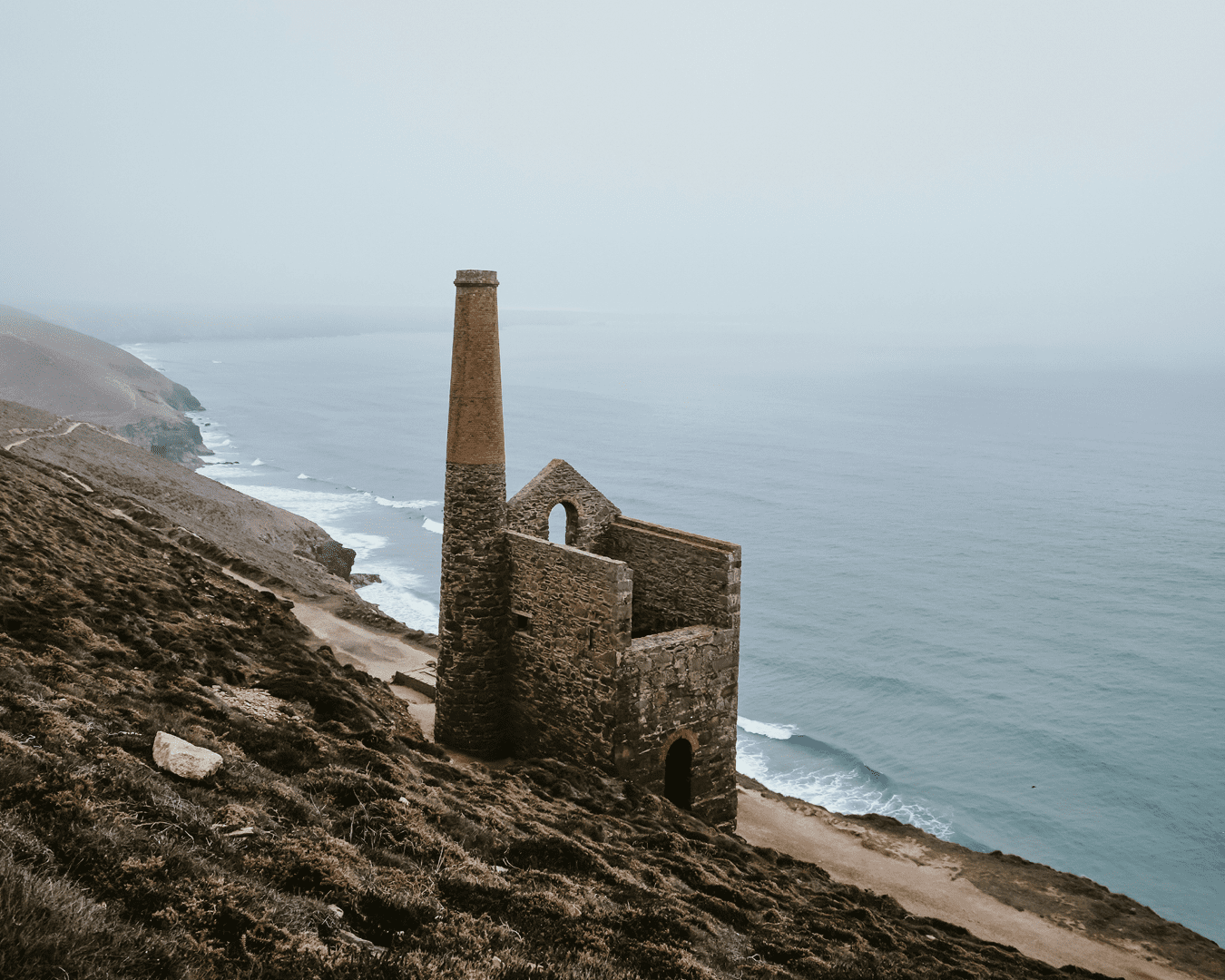
South coast
St Ives to Penzance
Flanked by golden sands and bathed in similar light, it’s perhaps little wonder that St Ives has attracted artists for generations. This charismatic harbour found itself at the heart of the British modernism movement with the arrival of artists including sculptor Barbara Hepworth, potter Bernard Leach and abstract painter Ben Nicolson after the Second World War, followed later by the likes of Peter Lanyon, Patrick Heron and Wilhelmina Barns-Graham.
Many worked from fishing lofts along Porthmeor beach, now overlooked by the striking form of Tate St Ives. There aren’t many galleries of this calibre located just steps from a top surfing beach, but once you’ve kicked off the sand and stepped inside, you’ll find an international roster of era-spanning artists (Mark Rothko’s Seagram series was on display during our visit) as well as a permanent collection that is the perfect primer to the town’s leading artistic lights.
The studio, gardens and former home of one of its number, Barbara Hepworth, sits high up with views over the St Ives rooftops. Here, tranquil gardens provide sanctuary from a town that is incredibly busy in summer months, where agapanthus, roses, magnolia and cherry trees create a verdant backdrop for some of the artist’s most striking, abstract sculptures.

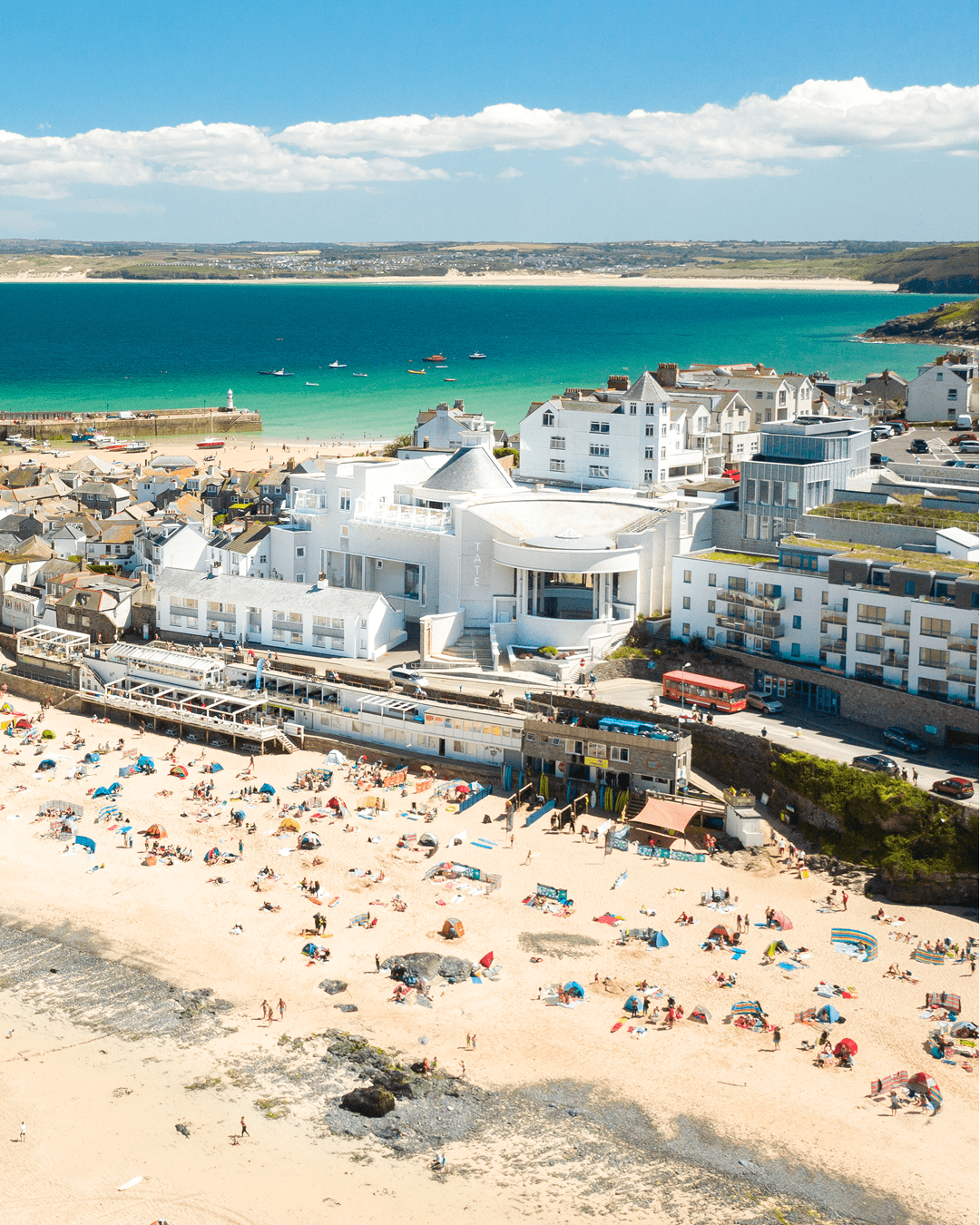
Described by Hepworth as a ‘remarkable pagan landscape’, the rugged coastal route west from St Ives ranks among one of the UK’s most spectacular drives. Barren moorland, stone-walled smallholdings and angular headlands curve southwards along the so-called Tin Coast, whose towering remnants of Cornwall’s mining industry are now a Unesco World Heritage Site. It’s a journey that leads past Cape Cornwall, where seabirds circle over disused industrial buildings, past the tiny airport that serves the Scilly Isles, and on to the village of Sennen. From the beach below, the thunderous roar of the Atlantic soundtracks this well-known surfing mecca, where a cafe offers board hire and instruction, and the Old Success Inn offers the perfect spot for a pint after braving the waves. Further south, skip the non-event of Land’s End, today a mawkish tourist trap, and instead wind down to Porthcurno.
It’s along the cliffs from the white sands and turquoise waters of this tiny village – made famous in the 19th century as the arrival point of the world’s first transatlantic telegraph cable – where one of the UK’s most stunning arts venues is found. Started in the 1930s by Rowena Cade and her gardener, the Minack Theatre takes the form of an ancient Greek amphitheatre carved into the granite cliffs, providing a remarkable open air setting with the Atlantic as backdrop. Throughout the warmer months, a roster of events from Shakespeare to contemporary bands make it an essential stop off. In the other direction from Porthcurno, tide-permitting, lies perhaps one of the world’s most beautiful beaches.
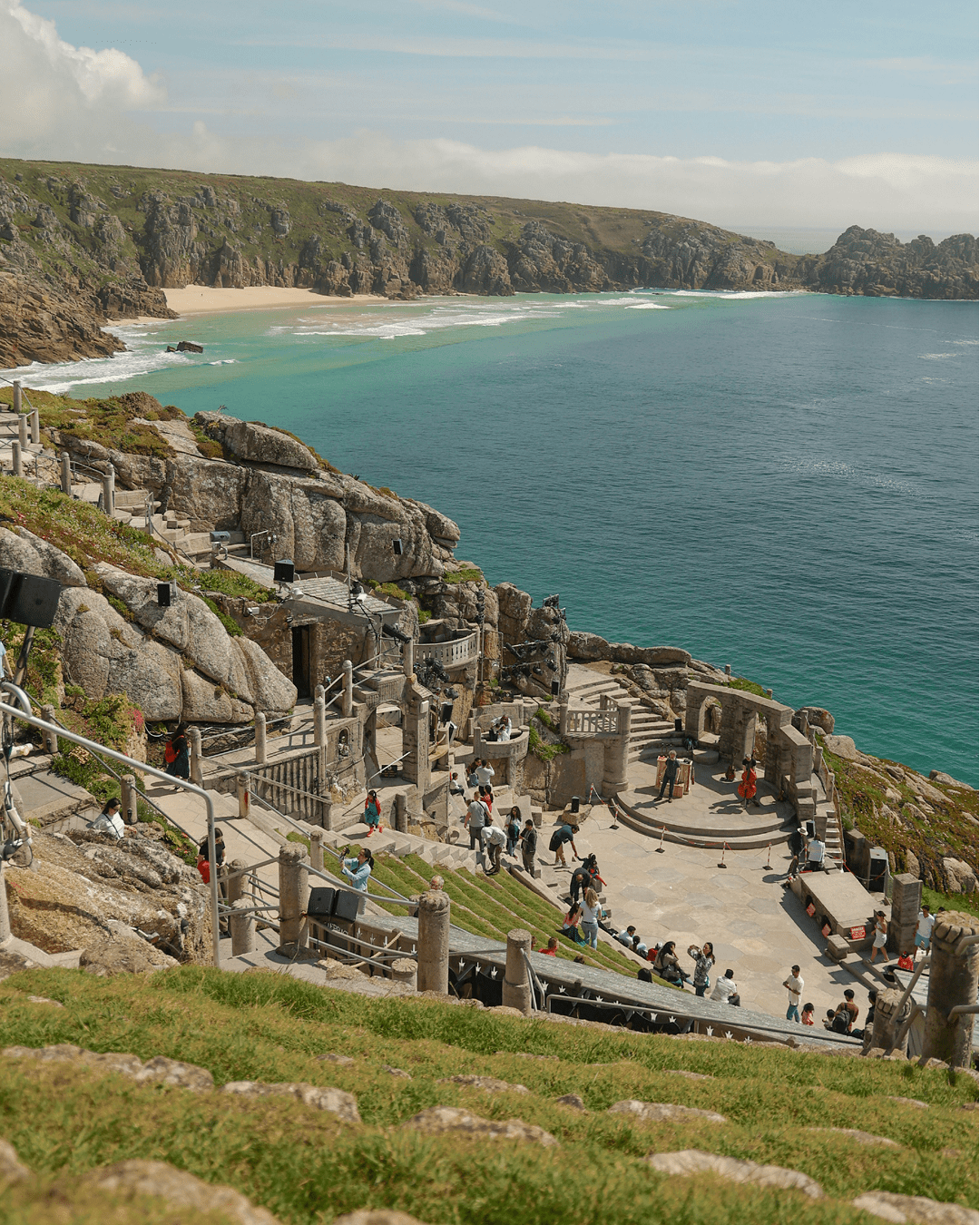
Penzance to Falmouth
On Penzance’s western extent, Newlyn is England’s largest fishing port. Here, within sight of the fish market and the town’s fleet of trawlers, Argoe shines bright as one of the county’s most thrilling seafood restaurants. In a clean-lined wooden-clad hut, flanked by an outdoor terrace, chef Ben Coombs and Newlyn fishmonger Richard Adams pool their skills to serve a nuanced menu centred around sustainability. Taking inspiration from the Med, seen in dishes like the fantail squid albondigas, this striking selection of dishes are often charcoal-grilled, focusing on nose-to-tail cuts from lesser known species, as well as local staples such as sardine or mackerel, served alongside biodynamic wines from the nearby Lovetts wine bar.
Bed down at the Chapel House in Penzance, a charismatic Georgian townhouse with eight rooms (including two suites), most of which overlook the harbour. Muted hues and plenty of natural light colour the communal areas, where walls come alive with a rotating selection of pieces from the Newlyn School of Art. Breakfasts and communal dinners at the weekend are served in the downstairs kitchen, made with love and showcasing local produce, while a hot tub and sauna are available to ease the aches of active travellers.
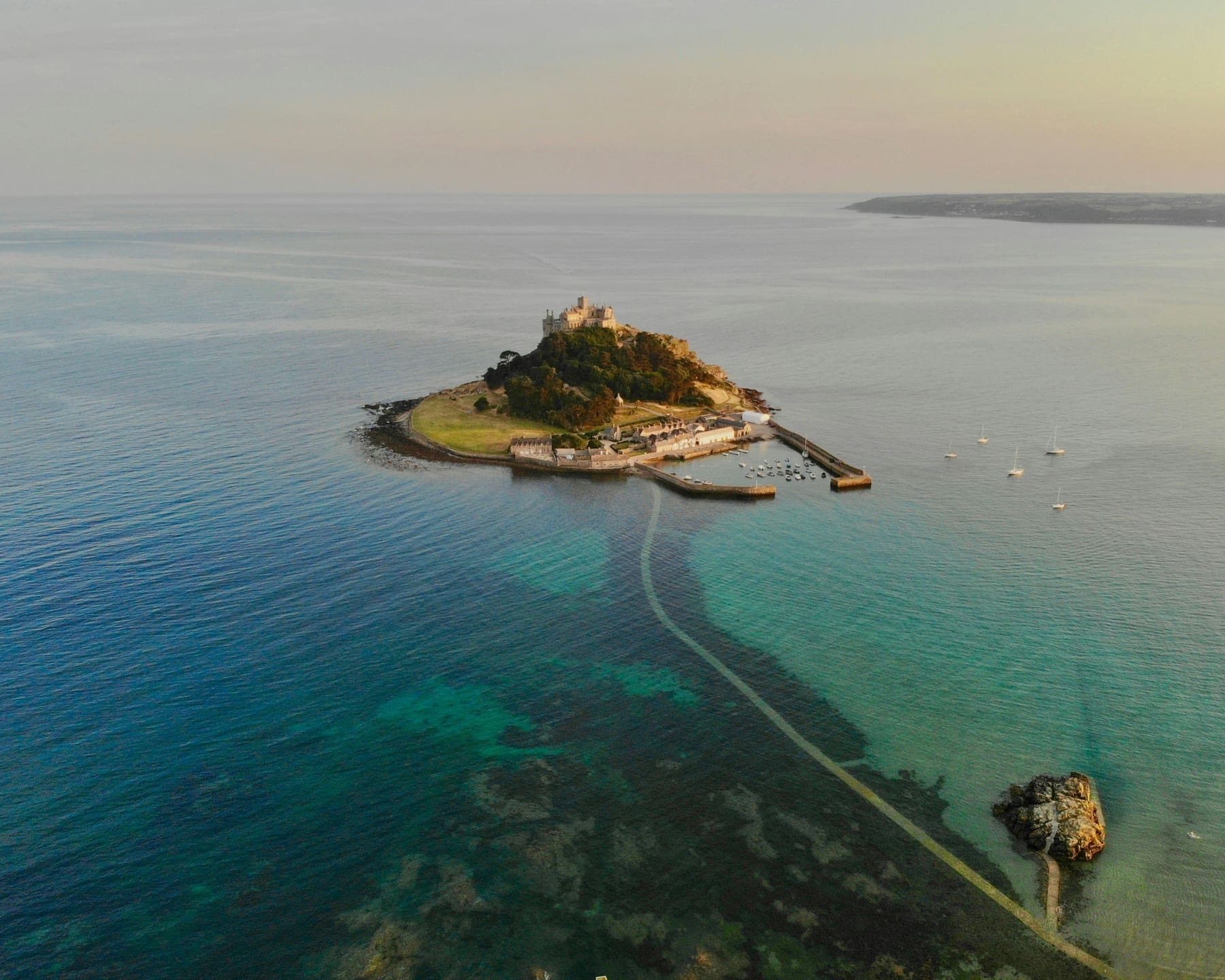
Visible from Chapel House’s sea-facing rooms on clear days, St Michael’s Mount is a rocky, tidal island rising up off the coast of Marazion. After a bracing dip in Penzance’s Jubilee Pool, a saltwater lido and geothermal pool, we speed eastwards towards Mount’s Bay, where its narrow causeway, accessible at low- to mid-tide, delivers hikers to this medieval castle and gardens, now run by the National Trust, which are open between May and October. The Mount was used recently as a filming location for HBO’s House of The Dragon series.
Further east, we stop for coffee at the excellent Origin Roastery and Cafe in the picturesque port town of Porthleven, home to a burgeoning food scene that peaks during its April food festival. South from Porthleven, the remote Lizard peninsula is a haven for wildlife and marks mainland Britain’s southernmost point, while the rolling hills and forested inlets of the Helford River are home to hidden bays, woodland walks and thatched waterfront pubs.

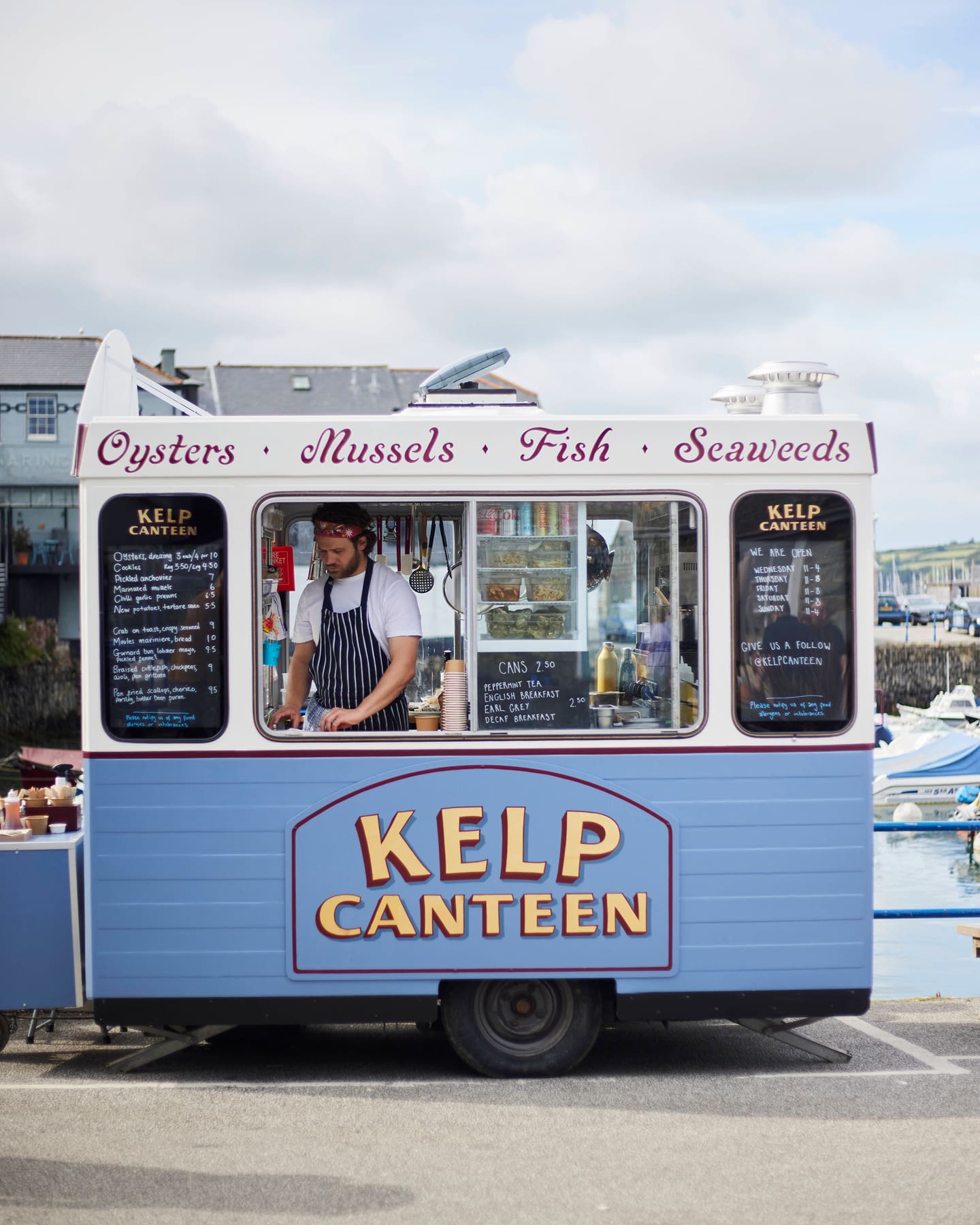
Falmouth to the Eden Project
From the east banks of the Helford, tiny lanes weave towards Falmouth, past the paddleboarders at Gyllyngvase beach to Pendennis Castle. Its imposing position overlooking the Fal estuary and Roseland Peninsula makes a great introduction to a charismatic maritime town with a cultural clout that comes courtesy of its sizable student population. Along its lively, bunting-clad high street, delis, boutiques and third-wave coffee shops sit alongside the ubiquitous pasty shops. After dark, grass-roots music venue The Cornish Bank hosts a plugged-in programme of artists, while an arthouse cinema, clutch of galleries and bars like Beerwolf, which doubles as bookshop, nod to Falmouth’s creative spirit.
Perfectly placed pre or post-dash to the St Mawes ferry, a recent addition to the waterfront comes in the form of Kelp Canteen. Building upon the age-old tradition of British seafood shacks, this lovingly restored ice cream van serves up seafood dishes that range from traditional pots of cockles to gojuchang-daubed mackerel buns. As owner Elliot Kett – who also runs regular seaweed foraging courses – brings out garlicky scallops and oysters in a seaweed dressing, he highlights their short journey from sea to plate, pointing out various pockets of the estuary where most of the menu had been sourced.

While much of Cornwall’s appeal lies in its centuries-old harbours and timeless landscapes, a more forward-looking dimension to Cornwall’s identity has emerged from the disused china clay pits of St Austell at the multi-domed Eden Project. An hour’s drive to the north east of Falmouth, skirting the cathedral city and county capital of Truro, this visionary project, opened at the turn of the millennium, is a vivid, verdant botanical showcase housed in bubble-wrapped biomes.
Head to the sticky summit of its tropical dome, which comes alive with banana and baobab trees, and venture through the Mediterranean dome (and accompanying restaurant) which are lined with olive trees and vines. Add in contemporary art, theatre and the Eden Sessions summer music series (recent headliners ranged from Massive Attack and Motorhead to Bjork and Bryan Adams) and it’s a compelling stop off that beautifully bridges Cornwall’s past and present.

